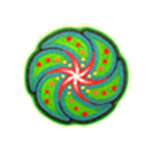
Beads - The perfect gem
Why they Wixárika use both yarn and beads in the ritual art and craft ?, Why these applications with wax stick? and What is "mitote"?
Materials like wax, glass beads, wool and cotton as sacred ceremonial objects and offerings. We do not know the meaning of the word wixarika, but we know that "Huichol" is an Anglicized version of this term. The language spoken by the Wixárika belongs to the branch known as Cora-Huichol, within the family of the Uto-Aztecan languages. The Huichol, who live isolated in the western Sierra Madre between the states of Jalisco, Nayarit and part of Durango and Zacatecas, they begin to express themselves artistically from their clothing and dress with incredible elegance.
The chaquira (kuka), for example, symbolizes water; therefore it covers the inner surface of the bowls, which are the ultimate water containers. The observations that emerged in the late nineteenth century, about some kind of ritual objects Huichol jícaras (xukurite) and statuettes of stone or wood representing ancestors deified, he said that already at that time were using glass beads in its decoration, "it is undoubtedly mollusk shells previously used for this purpose, "allows us to infer that the chaquira material is not a recent addition to the art of the Huichol. Chronic Father Joseph Arlegui, dating from 1737, describes the destruction of a Huichol ceremonial center where objects made with beads found. Today, the beadwork is sacred among Wixaritari "the chaquira means life". These small colored beads are also compared with corn seeds, and are subject to ritual uses, which can be purification.

Eyes of God
The Tsikuri or Eye of God is a rhombus yarn whose structure is made of two small cross rods, each diamond symbolized one year of protection. Studies on the yarn paintings almost always approach their iconography. However, they also carry a symbolism as textiles. Account the cosmogony mythology of the Great Nayar that the world is a fabric made from the hair of the primordial goddess. This deity, equivalent to the Spider Woman, wove diamond-shaped (Tsikuri), and their children danced mitote on it to widen. In fact, all kinds mitote dances can be interpreted as updates of this myth. The waist looms used by the Huichol knitters are, in this context, models sacred landscape, organized from two axes, the solstice and equinox: the warp threads represent the path of the pilgrimage that takes the place of origin in the west, the Pacific ocean to the place of dawn, Wirikuta desert in the east. The threads of the plot, apparently relate to the north-south daytime star performs annual movement.

In this context, we can also explain the importance of wax. According to myth, the first singer of mitote was Tsitsikame, Person Bee. Being murdered by his jealous concuño, Person Garza, his eyes became the first bees (xiete). Other parts of his body became the favorite plants of these insects, while the sound of his musical arc still alive in the buzz of diligent honey producers.
Why they Wixárika use both yarn and beads in the ritual art and craft ?, Why these applications with wax stick? and What is "mitote"?
When the initiation of newborn children is celebrated, the path of pilgrimage is symbolized throughout the festive courtyard with a thread that connects the drum of the singer, sitting in the center, with the altar located to the east, which represents Dawn Hill. Children identify with cotton balls and run through the yarn according to the narration of the singer, who describes in detail each of the places where you must go toward dawn.
Pilgrimage routes also are represented by wires or ropes in other contexts. The same jicareros of ceremonial centers (tukipa) use a rope with knots symbolizing the seasons trip to Wirikuta. Moreover, the Huichol term used to refer to their creation myths is kawitu, "the way of the caterpillar" (Kawi) that guides pilgrims. At the end of the path, the caterpillar into a butterfly, as beginners become initiated. Of these, those who best know the myths and pilgrimage routes are the kawiterutsixi. Singing kawitu equivalent to walking on pilgrimage routes, cosmogenic practice self-sacrifice, that is, creating the world. Therefore, it can be thought of as a fabric (warp) of ritual texts. If we consider that the scenes depicted in the Huichol tables are episodes of kawitus, we can see that in the Huichol art threads (strings) are routes and myths, and the world is like a fabric. Thus, it is not a coincidence that these parts are made precisely with yarn.


